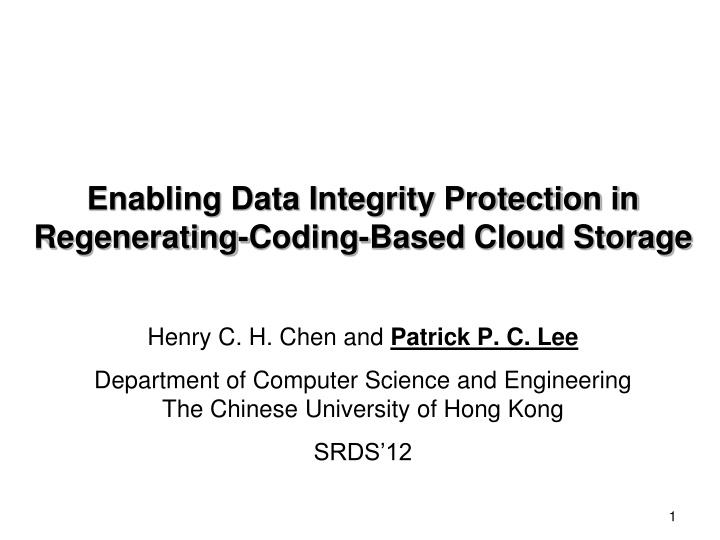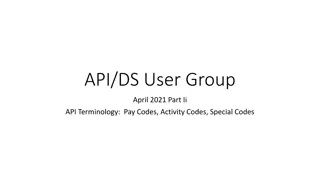Enhancing Data Integrity Protection in Cloud Storage Using Regenerating Codes
This paper explores the importance of data integrity protection in cloud storage and presents a solution using regenerating codes to detect corrupted data chunks, provide fault tolerance, and enable efficient recovery. It compares regenerating codes with Reed-Solomon codes and discusses their implications for faster data recovery. The use of network coding in NCCloud for implementing regenerating codes is also highlighted.
Download Presentation

Please find below an Image/Link to download the presentation.
The content on the website is provided AS IS for your information and personal use only. It may not be sold, licensed, or shared on other websites without obtaining consent from the author.If you encounter any issues during the download, it is possible that the publisher has removed the file from their server.
You are allowed to download the files provided on this website for personal or commercial use, subject to the condition that they are used lawfully. All files are the property of their respective owners.
The content on the website is provided AS IS for your information and personal use only. It may not be sold, licensed, or shared on other websites without obtaining consent from the author.
E N D
Presentation Transcript
Enabling Data Integrity Protection in Regenerating-Coding-Based Cloud Storage Henry C. H. Chen and Patrick P. C. Lee Department of Computer Science and Engineering The Chinese University of Hong Kong SRDS 12 1
Cloud Storage Cloud storage is an emerging service model for remote backup and data synchronization Is cloud storage fully reliable? 2
Cloud Storage Requirements Data integrity protection Detect any corrupted data chunks stored on cloud servers Fault tolerance Tolerate any cloud server failures Efficient recovery Recover any lost/corrupted data chunks with minimal overhead 4
Related Work Single server Provable Data Possession (PDP) [Ateniese et al. 07] and Proof of Retrievability (POR) [Juels et al. 07] Verify data integrity by spot-checking a fraction of large files via cryptographic means Multiple servers MR-PDP [Curtmola et al. 08] Target replication HAIL [Bowers et al. 09] Use erasure codes (e.g., Reed-Solomon codes) to provide less storage overhead than replication 5
Regenerating Codes Regenerating codes [Dimakis et al., 10]minimize repair traffic while maintaining same fault tolerance as erasure codes Implication: recover faster than erasure codes Idea: Do not reconstruct the whole file as in erasure codes Instead, read only the chunks (smaller than whole file) that are needed to recover the lost chunks Build on network coding NCCloud[Hu et al., 12] provides an implementable design of regenerating codes Functional minimum storage regenerating (FMSR) codes Designed for long-term archival storage 6
Reed-Solomon Codes Reed Solomon codes Repair traffic = M File of size M A A Server 1 B Proxy B Server 2 B A+B Server 3 A A A+B A+2B Server 4 n = 4, k = 2 (n,k) MDS property: any k out of n servers can rebuild original file. Conventional repair: Reconstruct whole file and generate data in new server 7
[Hu et al., FAST12] FMSR in NCCloud File of size M A B C D P1 P2 P3 P4 P5 P6 P7 P8 FMSR codes Repair traffic = 0.75M Server 1 Proxy Server 2 P3 P5 P7 Server 3 P1 P2 P1 P2 Server 4 n = 4, k = 2 Code chunk Pi = linear combination of original native chunks Repair in FMSR: Download one code chunk from each surviving server Reconstruct new code chunks via random linear combination 8
FMSR Property Servers (clouds) n(n-k) chunks Proxy P1 P2 P3 P4 P5 P6 P7 P8 P1 P2 P3 P4 P5 P6 P7 P8 k(n-k) chunks A B C D File partition encode distribute n=4, k=2 c1,1 c1,2 c1,3 c1,4 P1 P2 P3 P4 P5 P6 P7 P8 A . . . B C D c8,1 c8,2 c8,3 c8,4 Encoding matrix rank = k(n-k) Native chunks Code chunks 9
FMSR Codes FMSR codes Can achieve up to 50% repair traffic saving for general k = n-2 (i.e., RAID-6 tolerance) It is functional, i.e., fault tolerance is preserved It is suitable to long-term archival storage whose read frequency is rare Can we enable integrity protection atop regenerating codes, while preserving repair traffic saving? 10
Our Contributions Build a FMSR-DIP code, which enables data integrity protection, fault tolerance, and efficient recovery Export tunable parameters from FMSR-DIP to trade performance and security Implement and evaluate FMSR-DIP atop a real cloud storage testbed 11
FMSR-DIP Goals Threat model: Byzantine, mobile adversary [Bowers et al. 09] exhibits arbitrary behavior corrupts different subsets of servers over time Design goals: Preserve advantages of FMSR codes Work on thin clouds (i.e., only basic PUT/GET operations need to be supported) Support byte sampling to minimize cost 12
FMSR-DIP: Overview Servers / clouds FMSR FMSR-DIP code chunks code chunks file upload FMSR- DIP Storage interface NCCloud Users file download Four operations: Upload, Check, Download and Repair 13
FMSR-DIP: Upload 8 FMSR code chunks, 3 bytes each 14
FMSR-DIP: Upload Apply error-correcting code (ECC) to each chunk individually 15
FMSR-DIP: Upload XOR each byte with a pseudorandom value 16
FMSR-DIP: Upload For each chunk, calculate the MAC of the first 3 bytes 17
FMSR-DIP: Upload Upload the chunks to clouds Encrypt the metadata from NCCloud (which contains the encoding matrix) Append all MACs to metadata Replicate metadata on all servers 18
FMSR-DIP: Check Pick a row to check 19
FMSR-DIP: Check XOR with the previous pseudorandom values, and check their consistency20
FMSR-DIP: Check Recall that from FMSR encoding: Ax = P A = encoding matrix with rank = k(n-k) x = row of native chunks P = row of code chunks P is a linear combination of x Rank checking: Check if rank(A | P) = rank(A) = k(n-k) 21
FMSR-DIP: Download Download chunks from any 2 servers and verify with their MACs 22
FMSR-DIP: Download Remove pseudorandom values and pass to NCCloud for decoding23
FMSR-DIP: Repair Download 1 chunk from all other servers and verify with their MACs 25
FMSR-DIP: Repair Remove pseudorandom values and pass to NCCloud 26
FMSR-DIP: Repair NCCloud generates new chunks 27
FMSR-DIP: Repair Process the newly generated chunks as before 28
FMSR-DIP: Repair Upload chunks and update metadata on all servers 29
FMSR-DIP Optimizations By default, FMSR-DIP operates in units of bytes FMSR-DIP can also operate in blocks A block is a sequence of bytes Better checking performance, but less security We export different trade-off parameters that tune between performance and security We conduct preliminary security analysis on FMSR-DIP See details in paper and technical report 30
FMSR-DIP: Experiments Testbed environment Openstack Swift 1.4.2 1 proxy connected to storage servers over LAN NCCloud and FMSR-DIP deployed on proxy NCCloud uses RAMDisk as storage Storage scheme (4,2)-FMSR Goal: evaluate FMSR-DIP overhead over FMSR codes 31
Running Time vs. File Size 25 Time taken (s) 20 Transfer-Up DIP-Encode FMSR UPLOAD 15 10 5 0 FMSR-DIP overhead comparable to network transfer time in a LAN environment 100MB 50MB 20MB 10MB 5MB 1MB File size 8 Time taken(s) 6 DOWNLOAD Transfer-Down DIP-Decode FMSR 4 2 0 100MB 50MB 20MB 10MB 5MB 1MB File size 20 Time taken(s) Transfer-Up Transfer-Down DIP-Encode DIP-Decode FMSR 15 REPAIR 10 5 0 32 100MB 50MB 20MB 10MB 5MB 1MB File size
The Check Operation 80 1% check 70 60 Time taken (s) Misc. Transfer-Down Rank Checking PRF 50 40 30 20 Bottleneck in network transfer 10 0 Download block size 256B 1KB 4KB 7KB 25KB 256KB 30 256KB download block size 25 Time taken (s) 20 Misc. Transfer-Down Rank Checking PRF 15 10 5 0 100% 75% 50% 25% 10% 5% 1% Checking percentage 33
Conclusions Propose a design for efficient data integrity protection using FMSR on thin clouds Implement and evaluate the efficiency of the design Source code: http://ansrlab.cse.cuhk.edu.hk/software/fmsrdip/ 34
Backup 35
Recall: FMSR Encoding P1 c1,1 c1,2 c1,3 c1,4 P2 c2,1 c2,2 c2,3 c2,4 A P3 c3,1 c3,2 c3,3 c3,4 c4,1 c4,2 c4,3 c4,4 B P4 c5,1 c5,2 c5,3 c5,4 C P5 c6,1 c6,2 c6,3 c6,4 D P6 c7,1 c7,2 c7,3 c7,4 P7 c8,1 c8,2 c8,3 c8,4 P8 Encoding matrix rank = k(n-k) Native chunks Code chunks 36























